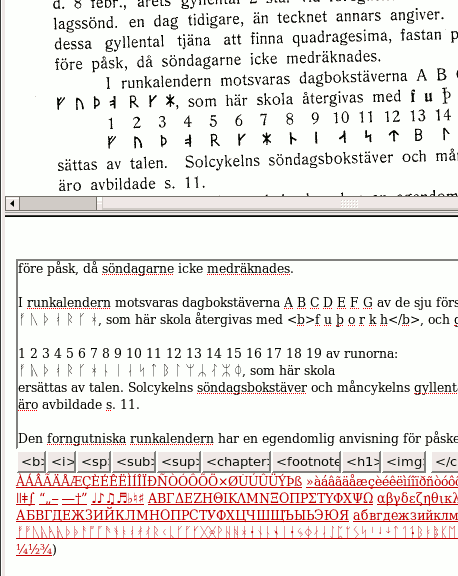
Proofreading with runes

Proofreading with runes |
If you go to page 10 of Nordens äldre tidräkning, you will find a page with a mix of modern-day (that is, 1908) Swedish text and viking age runic script. The runes were inspired by the Latin and Greek alphabets, but adopted for carving in wood and stone, since the vikings seldom used parchment and paper was unheard of. As a result, the runes have more straight lines and fewer curves. The letter R is perhaps the one that most resembles its Latin counterpart. It is also used (in red) in Project Runeberg's logotype. Letters B, F, I, S, and T are also quite similar. The older runic alphabet had 24 symbols, but was simplified to 16 symbols sometime around 800 A.D. When Christianity was introduced in Scandinavia around 1000 A.D., runes were gradually replaced with Latin script. You can learn more about the Runic alphabet from Wikipedia.
Many books in Project Runeberg focus on the history of the Scandinavian countries and provide samples of runic script. Since we scan pictures (or take photos) of the printed page, that is not a problem. OCR programs will typically not understand runes, but leave garbage characters in their place. But because runes come in such small amounts, it's no big problem to fix by hand. However, most of us don't have runic keyboards.
The picture to the right is a partial screenshot of what it can look like to proofread such a page. At the top is the scanned picture of the printed page. It happens to be a little skewed, but it is perfectly readable (if you read Swedish). At the center is the input form, where the OCR text can be edited. Below the form is a line of grey buttons that can be clicked to insert markup tags for boldface, italics, etc. And at the bottom are some lines with characters in the red link color used on Project Runeberg's website. These are the characters that can be missing from your keyboard. If you click one of these letters, it will be inserted in the edit form, at the point where you were last typing. In this case, the first red line contains normal Latin characters with accents. The second red line has musical notes and the Greek alphabet. The third line has Cyrillic (Russian) letters. The fourth line has runes, in their special alphabetic order (known as FUTHARK-HNIAS-TBMLR).
Now, for this screen to show on your computer, it needs to have the
proper fonts installed for all these alphabets. This should normally
not be a problem for modern versions of Ubuntu Linux or Microsoft
Windows XP with the Firefox web browser. If you experience any
problems with runic fonts, please write to the
editors@runeberg.org and
describe what kind of problems you had and what operating system and
web browser you were using. We'll see if we can find a solution.